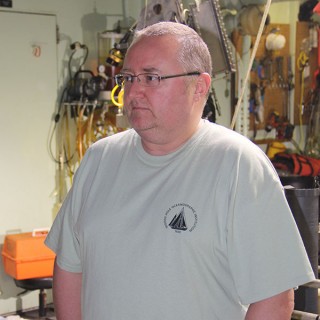
Chris German is a marine geochemist who has spent 25 years exploring Earth’s deep oceans for sites of seafloor fluid flow including, in particular, submarine hydrothermal vents. Growing up in Rochester, about 30 miles SE of London, England, he was surrounded by the influence of the oceans. Both of his grandfathers, his father and both of his brothers spent at least some part of their careers working in the local Naval Dockyard and even the school Chris attended was founded in 1701 specifically to train students as navigators at sea. Starting out in Cambridge in 1981, however, German’s intention was to train as a Chemical Engineer but a subsidiary course in Geology as part of his Y1 Natural Sciences degree got him smitten (not least because of the timely explosion of Mt St Helens) which subsequently led to a PhD in Marine Geochemistry – bringing together his twin interests in studying the Earth using Chemistry. Again, a timely fork in the road arose because it was during the first year of his PhD that fellow members of his research group came back from sea reporting evidence for the first hydrothermal vent-sites in the Atlantic Ocean – based on chemical signals in the overlying ocean.
Following a post-doc at MIT, 1988-90 which included his first chances to dive in the submersible Alvin, Chris returned to work for the UK Governments Institute of Ocean Sciences, later relocated and renamed to form the current National Oceanography Center and, over 15 years, perfected ever more efficient and sophisticated ways to explore the deep ocean using in situ sensors, deep towed instrument packages and, ultimately, pioneering the use of free swimming robots to sniff out and track down vents in previously unexplored oceans. In 2005, Chris returned to the US as a Senior Scientist at the Woods Hole Oceanographic Institution. From 2006 to 2014 his time there was split 50:50 between his own research and his role as WHOI’s Chief Scientist for Deep Submergence, playing an advisory role in overseeing the functioning of the National Deep Submergence Facility including the Human Occupied Vehicle Alvin, the Remotely Operated Vehicle Jason and the Autonomous Underwater Vehicle, Sentry. A key highlight of his 2 x 4 year terms in that role was overseeing the biggest overhaul of Alvin in its 50 year history and when that project was completed, with the new and improved Alvin returned to service, it was time to return to full time science and exploration.
To date, Chris has been instrumental in the discovery of new vent sites in every ocean: in the Pacific, Atlantic, Indian, Arctic and Antarctic. The current cruise – situated in the very heart of the South Pacific, equally distant from all the surrounding continents, may represent the most remote site that he has explored for venting, yet. But that record may not last for long. Later this year he heads to the Arctic near 87°N (just ~200 miles shy of the North Pole) to explore there and, increasingly, his attention is now turning to how the same skills he has learned on Earth, using robots to search for seafloor fluid flow and the unique and primitive life that they sustain, could be used to help explore our Solar System’s other Ocean Worlds.
